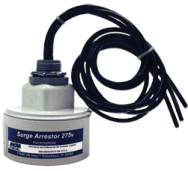1550 Cobb Industrial Dr. | P.O. Box 9098 | Marietta, GA 30065-2098
770-425-1355 (Phone) | 770-425-1354 (Fax) | info@alliedcorrosion.com (Email)
©2018 Allied Corrosion. All rights Reserved.
Made with ❤ by Mighty Good Marketing
Selected:

Installation has been eased by the symmetrical construction of the Surge Arrestor. The technician doing the installation only needs to connect the three wires of the Surge Arrestor to the appropriate terminals. For the most effective use, the wire lengths of the Surge Arrestor should be trimmed as short as is reasonable for the installation. In other words, there should be no excess wire! Do not coil excess wire, remove it. Coiled wire acts as an inductor and lowers the effective clamping action of the Surge Arrestor. Before installation, determine a suitable location for placement of the Surge Arrestor within the system to be protected. This position should not be subject to temperatures in excess of 65°C. A standard one-inch threaded fitting with nut is provided as a means of mounting, if desirable. The best position in the one that requires the least lead length.
Observe rectifier current before turning off, then turn off. With the rectifier turned off and the Surge Arrestor placed in what has been determined as a suitable position, take one of the three leads and bring it over to the ground connection. Allow about two to three inches of slack in the wire and cut the remainder off. Trim the insulation back about one-half inch, select a crimp connector and crimp. Bolt the wire to the ground clamp. repeat this procedure for the Anode and then the Cathode connection. Turn power on and observe that the rectifier current is the same. If the current is not the same turn off power immediately and check all connections. Turn power on again. If the current is too high, remove the Anode/Cathode connection and try again. If the current returns to normal, the Surge Arrestor may be defective, return it for a replacement. If the current remains high after removal of Anode and Cathode connections, check for other causes. Reinstall the Anode/Cathode connections after determining the problem. Check system current once again.
Turn off the AC power to the rectifier. Following the connection procedure outlined in the Anode/Cathode Ground Connection, connect ground, Hot and Neutral. Verify connections are tight and no shorts are present. Turn on AC power. Wait about one minute then feel the Surge Arrestor. If the Surge Arrestor feels warm, remove it and return it to M. C. Miller Co., Inc. as it may be defective.
The Surgistor Series of surge protectors are designed for use on AC or DC systems. Primary applications would be the protection of sensitive electronic equipment used in the remote monitoring or interruption of rectifier systems and the protection of the rectifier itself. The protector is designed for connection to the anode/cathode terminals and ground, and to the AC mains and ground. Two Surge Arrestors offer affordable protection to both the input and output of a rectifier system.
When a surge or transient exceeds the operational voltage of the Surge Arrestor, the surge is bypassed to ground. This protection continues until the surge voltage reduces below the threshold of the Surge Arrestor. The protection system resumes normal operation after the surge passes without interrupting either the input or output power. The symmetrical design of the Surge Arrestor clamps surges equally between any two leads. This maintains all potentials to a safe level.
| Clamp Voltage: | 275VAC; 275VDC |
| Surge Current: | 64,000 Amps (8/20μS wave) |
| Energy Absorption: | 1208 Joule (Watt Seconds) |
| Tolerance: | ± 10% |
| Temperature: | -40°C to +75°C |
| Height: | 3.5″ |
| Diameter: | 3.75″ |
| Weight: | 8.0 oz. |
| Wire: | 3 feet each X 3, 10 gauge stranded, 600V insulation |
Hermetically sealed construction can withstand indefinite immersion in water.
All units supplied with mounting hardware and crimp connectors.

1550 Cobb Industrial Dr. | P.O. Box 9098 | Marietta, GA 30065-2098
770-425-1355 (Phone) | 770-425-1354 (Fax) | info@alliedcorrosion.com (Email)
Made with ❤ by Mighty Good Marketing
We care about your privacy! In order to run a successful website, we are setting cookies and accessing and storing information on your device for various purposes. By continuing to browse this site, you are agreeing to our use of cookies.
If you wish to disable cookies, please visit our Privacy Policy for more information.
Got It! Thanks!Privacy policy